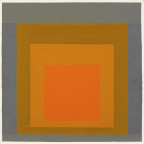Biography
Waddington Galleries presents an exhibition of works by Josef Albers in two sections; pre-Bauhaus drawings and paintings from his Homage to the Square series. The twelve figurative drawings date from 1917 to 1919. ‘Female Head Glancing Down’, 1918, shows a portrait observed with line and given solidity by flat areas of different tone. ‘In Seated Nude from Behind’, 1919, Albers has captured the female body with a minimal depiction of form, his assured lines of brushed ink achieving a result of economy, weight and balance within the white space of the paper. In the exhibition there are over forty works from 1951 to 1974 of the four different compositions that Albers used for his Homage to the Square paintings. Three compositions consist of three squares and the other of four squares. All are made from units of ten, and the placing of square inside square from bottom – to side – to top always has a ratio equal to 1–2–3. This means the middle square is lower than the painting’s central axis adding an intrinsic aura of gravity and stillness to its structure.
Albers mostly painted on hardboard. Marketed from the 1920s as Masonite in America, it is made from compressed wood pulp that has a homogeneous smooth side and a textured underside, its surface akin to heavy weave canvas. This textured side was primed between five to eight times and lightly sanded before Albers applied his colours, directly from the manufacturer’s tube, using a palette knife in a single, thin even coat. Painting from the centre outwards to ensure he kept his cuffs clean (a tip passed down to him by his housepainter father), Albers worked flat on make-shift tables under both warm and cool artificial light to enable him to see in controlled conditions how colours would interact. He meticulously, listed in most cases, on the back of works details of the specific manufacturer’s colours and varnishes used, as if the colours were catalogued components of an optical experiment. For example ‘Homage to the Square’, 1966, lists: Naples Yellow (Winsor & Newton) Naples Yellow (Permanent Pigment) Cadmium Yellow (Lefevre).
Many of the paintings have associative subtitles such as ‘High Autumn’, 1957, with its vivid orange and burnt red, evoking sensations of the New England autumn; or ‘Thicket’, 1961 with its central square of dense impassable green. Such words were always added after a painting was completed allowing the colour to form subsequent associations rather than the title hold prior influence. The paintings do not contain hard or masked edges; the colours are allowed to meet in a serene freehand boundary expressing a controlled and considered calmness. At a time when many of his contemporaries in America were producing large canvases, in scale Albers was more rooted to European easel-painting. Almost all of the paintings in the exhibition measure between 16 and 24 inches square.







